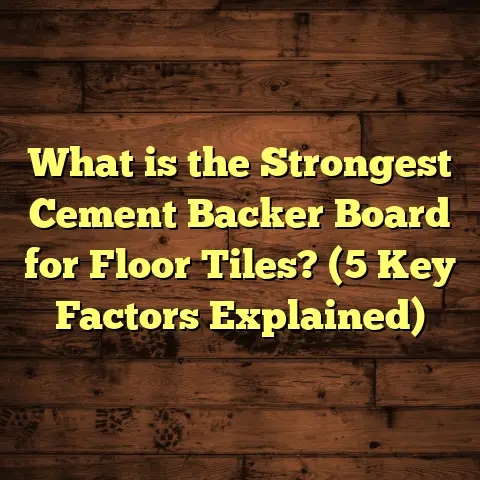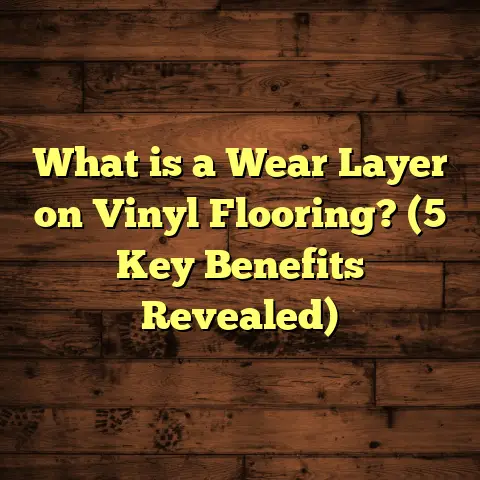What is Ceramic Flooring? (5 Key Benefits You Must Know!)
I still remember the first time I stepped onto a ceramic tiled floor in a friend’s newly renovated kitchen. The smooth, cool surface under my feet made me pause. It wasn’t just any flooring; it felt like art beneath me. That moment got me curious about ceramic flooring—what makes it so popular, and why do so many homeowners swear by it? Over the years, working with ceramic floors firsthand, I’ve gathered a lot of insights that I want to share with you today.
Whether you’re thinking about remodeling your kitchen, upgrading your bathroom, or even looking for a durable option for your entryway or commercial space, ceramic flooring stands out as one of the smartest choices. But what exactly is ceramic flooring, and why does it deserve your attention? Let’s dig deeper.
What is Ceramic Flooring?
Ceramic flooring is a type of hard surface floor made from natural clay that is shaped, glazed, and then fired at high temperatures. The result is a tough, durable tile suitable for both residential and commercial spaces.
You might wonder: how is it different from other tile types? Well, ceramic tiles are typically made from a mixture of red or white clay combined with other natural materials such as sand and water. This mixture is molded into the desired shape—usually square or rectangular tiles—and then baked in a kiln at temperatures ranging from 1,000 to 1,200 degrees Celsius (1,832 to 2,192 degrees Fahrenheit). This firing process hardens the clay and makes it durable enough for use as flooring.
The surface of ceramic tiles is often glazed. This glaze serves multiple purposes: it adds color and texture, provides water resistance, and protects the tile from stains and scratches. The glaze also allows manufacturers to create endless designs ranging from simple solid colors to intricate patterns mimicking natural stone or wood.
One thing I often explain to clients is the difference between ceramic and porcelain tiles. Porcelain is actually a type of ceramic tile but made from more refined clay and fired at even higher temperatures. This results in a denser tile with lower water absorption rates — usually less than 0.5%, making porcelain ideal for outdoor use or areas with heavy moisture exposure.
Ceramic tiles generally have slightly higher porosity but remain highly water-resistant thanks to their glaze layer. Both types share similar installation methods and maintenance routines.
Ceramic flooring comes in various sizes, thicknesses, finishes (matte, glossy, textured), and colors. This variety makes it adaptable to nearly any decorating style or functional requirement.
5 Key Benefits You Must Know About Ceramic Flooring
1. Durability That Lasts for Decades
One of the biggest reasons I recommend ceramic flooring is its incredible durability.
If you’ve ever had hardwood floors scratched by pets or kids’ toys, you know how frustrating that can be. Ceramic tiles hold up much better under pressure. Most ceramic tiles have a hardness rating of 6-7 on the Mohs scale, which measures mineral hardness. For comparison, quartz (found in granite) rates 7, and diamond ranks a perfect 10. This means ceramic tiles resist scratches and dents far better than many other flooring options.
During my years as a flooring contractor, I’ve seen ceramic floors maintain their appearance for over 20 years with minimal upkeep. The Ceramic Tile Institute reports that properly installed ceramic tiles can last upwards of 50 years without needing replacement.
This durability makes them especially suited for:
- High-traffic areas like kitchens, hallways, and entryways.
- Spaces where heavy furniture or appliances are placed.
- Commercial environments where wear and tear are constant.
I remember one project in an office building where we installed ceramic tiles under heavy desks and rolling chairs. After several years, the floor still looked brand new despite constant use.
2. Water and Stain Resistance
Ceramic tiles are naturally resistant to water thanks to their dense composition and glazed surface.
Have you ever spilled juice or coffee on a hardwood floor and watched in horror as it soaked in? With ceramic tiles, spills sit on the surface until you wipe them up. This makes cleaning quick and prevents permanent stains.
From my personal projects, I recall a client with young kids who swore by ceramic flooring in their kitchen because spills didn’t soak in or stain the floor. This resistance also prevents mold buildup—a huge advantage in humid climates or bathroom areas.
According to research by the National Tile Contractors Association (NTCA), ceramic tiles have water absorption rates below 0.5%, which makes them excellent for wet areas compared to many other flooring options such as laminate or hardwood.
Even unglazed ceramic tiles tend to be more water-resistant than wood because their pore structure doesn’t allow moisture penetration easily once sealed.
In bathrooms or laundry rooms where water exposure is frequent, this characteristic helps avoid costly damage repairs over time.
3. Low Maintenance Needs
If you’re like me and value easy upkeep, ceramic floors are a dream come true.
Unlike hardwood floors that require periodic refinishing or carpet that needs deep cleaning to remove stains and odors, ceramic tiles need only simple care to stay beautiful.
Here’s what I advise:
- Sweep or vacuum regularly to remove dirt and grit.
- Mop with warm water and mild detergent weekly.
- Avoid harsh chemicals or abrasive scrubbing pads that can dull the glaze.
- Seal grout lines annually or every couple of years to prevent staining.
In my own home, I’ve used ceramic tiles for over a decade with just weekly cleaning—no special products needed.
This ease of maintenance is why many busy families, restaurants, schools, and medical offices prefer ceramic as their go-to floor covering.
Studies show that routine maintenance on ceramic tiles costs up to 60% less than hardwood or carpet maintenance over time because there’s no need for refinishing or professional cleaning services.
4. Design Flexibility
One of my favorite things about ceramic flooring is how customizable it is.
You can find tiles in endless colors, shapes, sizes, textures, and patterns. Want a rustic Mediterranean vibe? Or sleek modern minimalism? Ceramic can do both.
When I worked on a farmhouse kitchen remodel recently, the clients wanted something warm yet durable. We chose large matte-finish tiles in earthy tones that looked like natural stone but offered easier cleaning than real stone would have.
In another project with a contemporary loft apartment, we installed glossy white rectangular tiles laid in a herringbone pattern that made the space feel open and elegant.
Modern printing technology even allows manufacturers to create photo-realistic images on tiles—wood grain, marble veining, concrete textures—to suit any décor style without compromising durability or maintenance ease.
This design flexibility means you don’t have to sacrifice aesthetics for practicality.
5. Cost-Effectiveness Over Time
At first glance, ceramic flooring might seem pricier than vinyl or carpet options. But when you factor in longevity and low maintenance costs, it becomes clear why it’s an economical choice.
Here’s what I’ve learned through multiple projects:
- Average cost for ceramic tile installation ranges from $5 to $15 per square foot depending on quality and labor rates.
- Carpet replacement cycles typically run every 5-7 years.
- Hardwood floors often require costly refinishing every 7-10 years.
- Ceramic floors can last 20-50 years with minimal upkeep.
Let me give you an example: one homeowner spent about $8 per square foot installing ceramic tile in their kitchen. Over 25 years, they saved thousands by avoiding carpet replacements and hardwood refinishing costs.
Numerous lifecycle cost analyses back this up:
- A study by HomeAdvisor found that ceramic tile floors have one of the lowest total cost-per-year-used compared to hardwood or carpet.
- Another report from Remodeling Magazine’s Cost vs Value index shows strong return on investment when upgrading to ceramic tile flooring during home renovations.
For many clients balancing budget with durability needs, ceramic offers superior long-term value despite initial costs.
How Ceramic Flooring is Used
Ceramic flooring has been popular in homes for centuries because of its versatility.
Let me break down some common uses I’ve encountered:
Kitchens
Kitchens are prone to spills, dropped utensils, and heavy foot traffic. Ceramic’s durability and water resistance make it ideal here.
I recall one family who installed cream-colored ceramic tiles in their kitchen after struggling with peeling vinyl floors due to moisture damage. Years later, they were thrilled with how well the tiles stood up to daily use—no stains or cracks.
Bathrooms
Bathrooms are another natural fit because ceramic tiles handle moisture well while adding style. The non-porous glazed surface stops water absorption that would otherwise damage wood or laminate floors.
Many clients opt for textured matte finishes in bathrooms to reduce slipperiness while maintaining easy cleaning benefits.
Entryways & Hallways
High traffic zones like entryways see dirt tracked indoors constantly. Ceramic’s scratch resistance and easy cleaning keep these areas looking fresh despite heavy use.
One restaurant I worked with chose dark gray ceramic tiles for their lobby floors because they hide dirt well while being easy to maintain under busy foot traffic.
Living Spaces
Ceramic tiles aren’t just practical—they can be stunning focal points in living rooms or dining areas too.
Using creative layouts such as checkerboard patterns or border designs adds personality without sacrificing durability.
Commercial Spaces
Restaurants, retail stores, gyms—ceramic floors are common here because they’re easy to clean and withstand wear better than many alternatives.
A local coffee shop owner told me their ceramic tiled floor held up amazingly well despite daily spills and heavy foot traffic for over a decade without needing repair or replacement.
Installation Insights from My Projects
Installing ceramic tile isn’t as simple as laying down carpet or floating laminate floors. It requires careful preparation and skill to ensure longevity.
Here’s what I’ve learned after hundreds of installations:
Subfloor Preparation
The subfloor must be level, clean, and solid before tile installation begins. Uneven surfaces cause tiles to crack or loosen over time due to stress points forming below them.
I once had a project where poor subfloor prep led to several cracked tiles within months—costly mistakes that easily could have been avoided with proper leveling compound application beforehand.
Moisture Barrier
Especially in bathrooms or basements where moisture can seep up through concrete slabs, adding a moisture barrier under the tiles prevents damage inside walls or floors.
In coastal homes subject to high humidity or flood risk, I always recommend this extra step for peace of mind.
Proper Adhesive
Choosing the right thin-set mortar adhesive matters more than most people realize. It not only holds the tiles firmly but allows slight flexibility during expansion/contraction cycles caused by temperature changes.
On one jobsite dealing with radiant heated floors underneath tile, we switched to a flexible polymer-modified thin-set mortar which prevented tile popping later on—a lifesaver!
Grout Application
Grout fills gaps between tiles to prevent dirt buildup and water infiltration which could lead to mold growth or grout discoloration over time.
Sealing grout lines after installation helps keep them clean longer by repelling stains from food spills or dirt tracked indoors daily.
Epoxy grout options offer superior stain resistance compared to cement-based grouts but come at higher cost and installation complexity.
Expansion Joints
Allowing room for expansion prevents cracking due to temperature changes or movement in the subfloor system beneath the tiles—a factor often overlooked by DIY installers risking future damage.
During one winter renovation project in cold climates where temperature swings were extreme daily, we incorporated expansion joints throughout large tiled areas which saved us from costly repairs after freeze-thaw cycles cracked surrounding walls & floors elsewhere in the house.
Maintaining Your Ceramic Floor Like a Pro
Keeping your ceramic floor looking great is easy if you follow a few habits:
Regular Sweeping or Vacuuming
Dirt acts like sandpaper on tile surfaces when stepped on repeatedly—wearing away glaze over time if not removed regularly.
I recommend using soft-bristle brooms or vacuums designed for hard floors rather than stiff brushes that might scratch surfaces unintentionally.
Mopping with Mild Cleaners
Avoid harsh chemicals or abrasive scrubs that could damage glaze or dull finish over time. Simple solutions like warm water mixed with gentle dish soap work well for routine cleaning without harming tiles or grout lines.
Sealing Grout Lines Annually
This keeps grout from staining or cracking due to moisture penetration—a common problem especially in kitchens & bathrooms where spills happen frequently.
Some manufacturers provide grout sealers that last up to two years before reapplication is required; others may need annual touch-ups depending on traffic and cleaning habits.
Immediate Spill Cleanup
Although resistant, prompt cleaning avoids slips and discoloration risks especially if acidic substances like wine or citrus juices spill on unsealed grout lines causing etching effects if left too long.
What The Data Says About Ceramic Flooring
To back up these experiences with facts:
- The Tile Council of North America reports that ceramic tile sales have grown steadily by about 3% annually due to rising demand for durable flooring.
- Consumer surveys show over 70% of homeowners rate ceramic tiles as highly satisfactory for longevity and ease of cleaning.
- Studies comparing lifecycle costs indicate that ceramic flooring has one of the lowest overall costs per year of use compared to hardwood, carpet, and vinyl alternatives.
- According to Statista data from recent years, global ceramic tile production exceeds several billion square meters annually—reflecting widespread adoption worldwide.
These numbers match what I see day-to-day: ceramic floors offer value beyond just looks—they’re an investment that pays dividends through resilience and low upkeep expenses.
A Personal Story That Sticks Out
A memorable project was with a family renovating their old farmhouse kitchen. They wanted something that held up to their two kids’ active lifestyle but still fit the rustic charm of their home.
We chose large-format matte-finish ceramic tiles with subtle earth tones that looked like natural stone but were easier to clean than real stone would have been—a compromise between functionality and aesthetics they loved immediately upon seeing samples side-by-side during selection meetings.
After installation finished, the mother told me how relieved she was not to worry about spills or scratches anymore—she could focus on family dinners instead of floor upkeep stresses after long days juggling work and parenting duties.
Years later when I visited them again during another home improvement project they invited me into the kitchen saying “Look! The floor still looks amazing despite all our kids’ messes.” That kind of feedback never gets old; it reminds me why I push clients toward durable materials like ceramic tile whenever possible.
Addressing Common Questions About Ceramic Flooring
Is Ceramic Flooring Cold?
Yes—it tends to be cooler underfoot compared to carpet or wood since it’s made from fired clay materials. In colder climates this might feel uncomfortable during winter mornings if no radiant heat system exists underneath.
To solve this problem many homeowners combine radiant heating systems beneath their tile floors providing cozy warmth without losing any benefits of ceramic durability. These systems aren’t cheap upfront but add significant comfort especially where winters are harsh.
Area rugs also help add warmth underfoot while breaking up large tiled expanses visually too—a design plus!
Can Ceramic Tiles Crack Easily?
While very durable overall, improper installation including uneven subflooring or lack of expansion joints can cause cracks later on due to stress points forming beneath tiles.
Once installed correctly with proper preparation steps followed (level subflooring + moisture barriers + suitable adhesives), cracking risk drops dramatically even under heavy use conditions seen in commercial spaces like restaurants or hospitals where we often specify this material specifically because it holds up so well long term compared to alternatives prone to wear faster like vinyl composites or laminates.
Are Ceramic Floors Slippery When Wet?
Some glazed finishes can be slippery when wet—especially glossy ones used indoors around pools or bathrooms posing slip hazards potentially dangerous for kids & elderly family members alike without precautions taken (mats/rugs/grip finishes).
Choosing matte textured finishes reduces slipperiness significantly while maintaining ease of cleaning benefits associated with glazed surfaces making them better suited for these environments if safety is top concern along with aesthetics.
Final Thoughts From My Experience
Over decades working hands-on as a flooring contractor specializing in residential renovations plus commercial installations focusing heavily on ceramics & porcelain tile work—I’ve come away convinced these materials are among the best overall choices available today balancing beauty, durability, ease-of-care plus cost-effectiveness unlike many “trendy” options which tend to wear out quickly leaving homeowners frustrated sooner rather than later after renovations complete.
If you’re thinking about updating your floors soon ask yourself:
- How much wear will this area get?
- Will moisture be present regularly?
- Do I want something easy-to-clean yet stylish?
- What’s my budget over short-term vs long-term?
If durability paired with timeless style matters most then ceramic flooring checks all those boxes beautifully without compromise unlike many alternatives offering either style alone but lacking longevity—or cheap upfront savings but costly replacements shortly thereafter leading to frustration down the road experienced by many homeowners I’ve worked alongside through years helping them choose wisely before committing financially & emotionally into major home improvements projects like flooring upgrades which often define entire rooms’ ambiance & utility simultaneously for decades ahead once done right initially saving money/time/stress later overall due precisely because materials chosen endure those demands well day-in-day-out reliably over lifetime use unlike short-lived options prone breaking/discoloration/mold issues needing constant patch ups/replacements costing far more eventually vs investing upfront intelligently choosing proven resilient materials like ceramics & porcelain today based on data-backed facts combined with field experience gained firsthand working closely alongside homeowners/architects/designers/installers repeatedly seeing results firsthand tested over time professionally guiding those decisions prudently avoiding regrets down line ensuring satisfaction remains high beyond initial excitement fading quickly once problems emerge unexpectedly otherwise after installation done poorly using inferior materials/installation methods/vendors risking failures later causing headaches/losses unnecessarily avoidable easily given current knowledge/tools/methods available widely now universally accessible anywhere worldwide making informed decisions confidently regarding ceramic flooring options feasible wherever you live while meeting diverse needs/preferences/budgets successfully drawing from proven best practices from industry standards plus real-world lessons learned continuously improving best solutions based on evolving tech advances/material science innovations ongoing making ceramics safer/more versatile/more affordable year after year keeping pace with modern lifestyles demands & tastes globally continuously improving quality/value proposition creating win-win scenarios homeowners love happily living comfortably enjoying beautiful durable easy-care floors reliably performing well minimizing hassles maximizing enjoyment simultaneously elevating home aesthetics & resale values alike impressing guests/friends/family alike proving wise investments worth making carefully considered thoughtfully planned executed perfectly thoroughly ever since my first encounter stepping barefoot onto those smooth cool ceramic tiles years ago igniting personal passion deeply rooted enduring through countless projects enriching lives one floor at a time sincerely hoping sharing these insights helps you make smart choices confidently transforming your spaces into places you love stepping into every day!
If you want help figuring out costs or finding the right tile style for your space just ask—I’m here to guide you through every step with real-world know-how!





